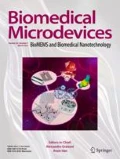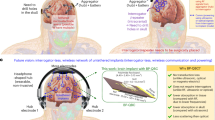Abstract
Wireless signal transmission will play a critical role in developing reliable subdural spinal cord stimulation systems. We have developed an approach to inductively coupling signals across the epidural spacing between the pial and epidural surfaces. The major design constraints include tolerance of coil misalignments from spinal cord geometries in addition to reasonable power efficiencies within the expected range of movement. The design of the primary side as a driving circuit is simplified by several turns of commercial magnetic wire, whereas the implanted secondary side is implemented in a micro-planar spiral coil tuned to a resonant frequency of 1.6 MHz. We present the results of wireless inductive coupling experiments that demonstrate the ability to transmit and receive a frequency modulated 1.6 MHz carrier signal between primary and secondary coil antennae scaled to 10 mm. Power delivery is in the range of 400 mW at a link efficiency of 32 % for strong coupling (coil separations of 0.5 mm ) and in the range of 70 mW at 4 % efficiency for weak coupling (coil separations of 10 mm).











Similar content being viewed by others
References
ANSI, IEEE c95. 1-1992: IEEE standard for safety levels with respect to human exposure to radio frequency electromagnetic fields, 3 khz to 300 ghz (The Institute of Electrical and Electronics Engineers, New York, 1992)
J. Drinkall, R. Porter, C. Hibbert, C. Evans, Value of ultrasonic measurement of spinal canal diameter in general practice. Br. Med. J. (Clinical Research Ed.) 288(6411), 121–122 (1984)
M. Howard, M. Utz, T. Brennan, B. Dalm, S. Viljoen, N. Jeffery, G. Gillies, Intradural approach to selective stimulation in the spinal cord for treatment of intractable pain: design principles and wireless protocol. J. Appl. Phys. 110, 044702 (2011a)
M. Howard, M. Utz, T. Brennan, B. Dalm, S. Viljoen, J. Kanwal, G. Gillies, Biophysical attributes of an in vitro spinal cord surrogate for use in developing an intradural neuromodulation system. J. Appl. Phys. 110, 074701 (2011b)
H. Ko, J. Park, Y. Shin, S. Baek, Gross quantitative measurements of spinal cord segments in human. Spinal Cord 42(1), 35–40 (2004)
W. Ko, S. Liang, C. Fung, Design of radio-frequency powered coils for implant instruments. Med. Biol. Eng. Comput. 15(6), 634–640 (1977)
R. Puers, G. Vandevoorde, Recent progress on transcutaneous energy transfer for total artificial heart systems. Artif. Organs 25(5), 400–405 (2001)
J. Reid, Effects of flexion-extension movements of the head and spine upon the spinal cord and nerve roots. J. Neurol. Neurosurg. Psychiatry 23(3), 214 (1960)
V. Sharma, D. McCreery, M. Han, V. Pikov, Bidirectional telemetry controller for neuroprosthetic devices. IEEE Trans Neural Syst Rehabil Eng 18(1), 67–74 (2010)
C. Shealy, N. Taslitz, J. Mortimer, D. Becker, Electrical inhibition of pain: experimental evaluation. Anesth. Analg. 46(3), 299 (1967)
B. Smith, Z. Tang, M. Johnson, S. Pourmehdi, M. Gazdik, J. Buckett, P. Peckham, An externally powered, multichannel, implantable stimulator-telemeter for control of paralyzed muscle. IEEE Trans. Biomed. Eng. 45(4), 463–475 (1998)
G. Suaning, N. Lovell, Cmos neurostimulation asic with 100 channels, scaleable output, and bidirectional radio-frequency telemetry. IEEE Trans Biomed Eng 48(2), 248–260 (2001)
C. Wang, C. Hsu, S. Tseng, D. Shmilovitz, A one-time implantable wireless power bidirectional transmission spinal cord stimulation system, in 2010 IEEE International Symposium on VLSI Design Automation and Test (VLSI-DAT) (2010), pp. 288–291
B. Waters, A. Sample, P. Bonde, J. Smith, Powering a ventricular assist device (vad) with the free-range resonant electrical energy delivery (free-d) system. Proc. IEEE 100(1), 138–149 (2012)
C. Zierhofer, E. Hochmair, Geometric approach for coupling enhancement of magnetically coupled coils. IEEE Trans. Biomed. Eng. 43(7), 708–714 (1996)
Author information
Authors and Affiliations
Corresponding author
Rights and permissions
About this article
Cite this article
Song, SH., Gillies, G.T., Howard, M.A. et al. Power and signal transmission protocol for a contactless subdural spinal cord stimulation device. Biomed Microdevices 15, 27–36 (2013). https://doi.org/10.1007/s10544-012-9684-1
Published:
Issue Date:
DOI: https://doi.org/10.1007/s10544-012-9684-1




